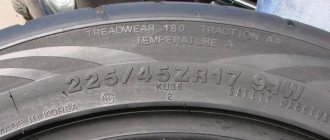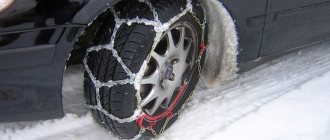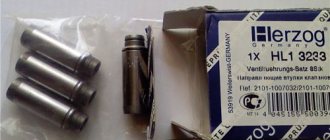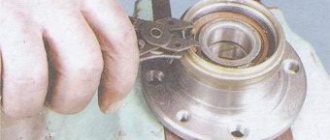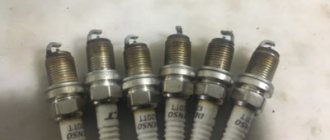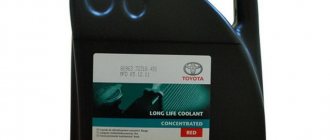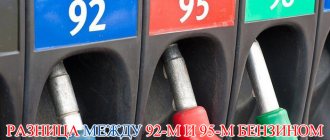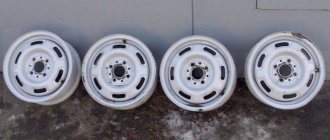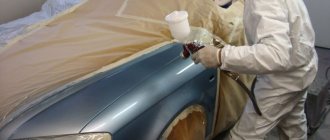The shock absorber is an important component of a modern car. They are used to dampen shocks and impacts transmitted from the wheels to the car body. Due to their presence, the operation of the machine becomes much more comfortable. The production of racks is carried out by many manufacturers on different continents - the quality and cost differ significantly.
We must remember: not all manufacturers that have been present in this segment for a long time can boast of good quality. It is important to carefully select parts. Sometimes not only the comfort of use depends on this. But also the safety of the driver and passengers on the road.
Some of the best shock absorber struts are produced in Germany. But it is important to remember the need to approach the choice wisely. The optimal choice in terms of price and quality ratio:
- Sachs;
- BOGE;
Sachs
This company specializes in the production of transmission and suspension elements. The main feature is the ability to install the same kit on a passenger car or SUV. This will not change the ride comfort. Varieties:
- Super Touring – can be oil or gas, additionally equipped with springs;
- Advantage – positioned as an improved modification of standard parts;
- Sporting – tough, but allowing you to “feel” the road well.
BOGE
They specialize in the production of front, rear gas or oil shock absorbers for cars from German manufacturers (BMW, Audi and others). They are popular, but not due to their high quality. The rating is low, but due to the cost they easily compete with products from China. Another plus is the “rich” assortment:
- Pro-Gas – gas type shock absorbers;
- Turbo 24 - are monotube shock absorbers, used for extreme driving;
- Turbo Gas – gas-oil;
- Nivomat – installed on vehicles with constant heavy load.
The best Japanese and Chinese shock absorbers
The best shock absorbers for cars presented in the list work reliably. Among a fairly large number of manufacturers, it is their models that have become the most popular all over the world. Japanese and Chinese dampers were especially loved by European automobile concerns. They are installed on many budget brands of cars. Japanese automakers prefer this reliable filling to more expensive analogues.
Tokiko
Less common than Kayaba, but softer in perception, Tokico shock absorbers cannot be called very popular. The company has only two manufacturing plants: one of them is located directly in Japan, and the other is based in Thailand. But the quality of production in both cases is excellent, which is not typical for most American and European factories. Only a fifth of exported Japanese cars have this wonderful suspension - this is the trend of the year: Toyota Camry, the heavier Toyota RAV-4 and almost all Lexus cars, which rely on both speed and comfort.
In addition, shock absorbers are found on some American cars (usually Ford models) and products of the Chinese automobile industry - Gili, Cherry and (dubious information) Lifan. The rest of the market is given over to the more popular Kayaba. However, Tokico has one very important advantage over its eternal competitor - the dampers of this company are much less counterfeited.
Kayaba
A young but potentially very strong company, supplying about 80% of the Chinese market with shock absorbers, as well as supplying goods to European and American cars. In their country, they are widely used in Mazda, Honda and almost all Toyota cars (with the exception of Camry and RAV-4).
Since its founding, the company’s bosses wanted to grab a larger piece of the market, so they launched several conveyor lines for the production of road and sports shock absorbers. In general, the series nomenclature is as follows:
- Exel-G – gas-oil shock absorbers for city roads, characterized by increased controllability and minimalist comfort (for those who like to “powder” within the city);
- Premium – a series of oil shock absorbers with increased comfort;
- Gas-a-Just - reinforced monotube rear shock absorbers, suitable for the popular Japanese drift;
- Ultra SR – a lightweight series of sports dampers to ensure better vehicle stability;
- AGX – adjustable sports-type gas shock absorbers that can be adjusted to your driving style;
- MonoMax is a gas-oil series operating under high internal pressure. Minimum comfort and maximum controllability at the cut-off point.
Sensen
Sensen shock absorbers are an affordable alternative to Kayaba. The company's high-tech enterprises are fully robotic and are considered the most advanced in China. Officially, the country of origin for Sensen is China, but factories are also located in Taiwan, Thailand, and Malaysia.
By focusing on low cost, the company's developers and engineers were able to do the impossible. A mandatory stage is strict testing. That's why all Sensen shock absorbers come with a certified warranty.
The company's product range is not so large: shock absorbers are produced only for passenger cars and medium-sized cars. This specialization helps us focus on our core products while constantly working to improve their durability and quality.
Advantages:
- Chrome plated shock absorber rods are made from high carbon steel;
- The seals are supplied by the Japanese company Nok;
- Corrosion protection;
- Teflon coating of bushings;
- Robotic seam welding.
Flaws:
- After the warranty period they quickly fail.
Having bet on releasing an analogue at a more attractive price, Sensen was not mistaken. Consumers quickly appreciated products that met quality standards. The company's shock absorbers are installed by powerful automobile concerns Dongfen and Nissan.
Miles
Miles' head office is located in Belgium. This is where European participation in production ends; all shock absorbers are produced in Asian countries. However, Miles damper systems are becoming increasingly popular.
The young company has set a course for advanced technologies. All factories are equipped with the latest technology. Many operations are robotic. The result is good quality at a low price. And the ever-growing demand for products. In many respects, Miles shock absorbers are superior to their original counterparts.
Advantages:
- The working cylinder tube has a seamless design;
- Disc type valve system;
- Sealing gland NOK Corporation;
- Highly refined oil made in Korea;
- Precision machined chrome rod;
- Special additives eliminate foaming and aeration;
- Compliance with European quality standards.
Flaws:
- The front struts begin to leak after hard use.
The Miles company is establishing contacts with developers of automotive parts from Russia. This confirms the desire to take a strong position in the market and not disappoint consumers.
Patron
The company's shock absorbers are 20-40% cheaper than their analogues. Experienced drivers were initially alarmed by this fact. But as practice has shown, Patron dampers demonstrate high-quality operation at a low price. All brand products are included in the world's largest specialized auto parts catalog TecDoc, and the company itself is internationally registered.
The Patron brand is owned by the Shate-M Plus corporation and has 70 factories located in 11 countries. Including in Belgium, South Korea, Italy, Belarus, China. All models have a single control system. It consists of testing centers equipped with powerful test benches. Patron dampers work great in American, European, Asian cars class=”aligncenter” width=”701″ height=”276″[/img]
Advantages:
- Special additives in twin-tube shock absorbers prevent foaming;
- Adaptive models instantly change stiffness;
- Monotube dampers can be installed in any position;
- They have an improved cooling system;
- Quality similar to the originals.
This is interesting: Prevention and lubrication of the starter - what can be used to lubricate it: types, characteristics of products
Flaws:
- Short warranty period;
- At high temperatures, hardness increases.
In the Patron assortment, you can select shock absorbers by car brand or find a universal model that can be easily adjusted with your four-wheeled friend.
Bilstein
It positions itself on the market as a manufacturer of shock absorbers for premium cars - a segment the manufacturer shares in half with KONI. One of the indicators of the company's status is the fact that the automaker Subaru uses Bilstein springs on the assembly line when assembling most of its models. A wide range is another plus. There are gas, oil, gas-oil modifications.
Krosno
As the name suggests, it is a brand of Polish origin. It specializes in the production of suspension elements. It cannot be said that the products he produces are diverse. But it sells well due to the optimal price-quality ratio. The reason for the low durability is the purpose of the parts: they were designed for driving on smooth European roads. Not designed for potholes and hummocks of domestic “autobahns”. The advantage is the presence of a sealing rod. It prevents dirt and dust from entering the unit.
Which shock absorber is better: gas, oil or gas-oil?
The question of which shock absorbers are more reliable is very controversial. By and large, each of the varieties of this product is very popular. Therefore, it is almost impossible to say which shock absorbers are the most suitable. Each motorist chooses them based on his unique driving style and desired level of comfort.
Gas struts have become more widespread among domestic drivers. As practice shows, they last much longer than all other types. And on bad roads this quality is priceless. For example, for a VAZ 2114 such products will be the most effective. And if we talk about foreign cars, especially used ones, many models from leading manufacturers install gas-oil shock absorbers.
Gas and oil varieties have their own special characteristics. Fans of a hard suspension choose the first option, and lovers of a soft ride choose the second type. And how these varieties differ can be understood by examining each of them in detail.
Types of shock absorbers
Vehicles must be equipped only with high-quality suspension components. Therefore, when choosing shock absorbers you need to approach the issue responsibly. First of all, you should decide on one of three types:
- Gas
- Oily
- Gas-oil
First, it is important to clarify that gas-oil shock absorbers are a subtype of gas-type shock absorbers. It's essentially the same thing, but with some differences.
Gas shock absorbers are considered the most unpretentious. They, as many car enthusiasts say, do not leak, do not require constant inspection and are not that expensive. They work not only for compression, but also for decompression. But, for some reason, with them, just like with other types, there is always a lot of hassle.
Oil shock absorbers are considered simpler. The main operating factor in them, as everyone knows, is a special oil. It is thanks to it that body vibrations quickly pass, and the springs and all parts of the other elements of each part of the suspension remain intact when driving on bad roads. There is no damage to the car body either.
A more detailed review should begin with such a section of the article as the gas-oil type of products. The shock absorber design of this sample consists of two cylinders. The first contains oil, as well as a piston and rod. The second one is filled with 3 atmospheres of air.
So that drivers can make the only right choice, it is necessary to explain the principle of operation of the gas-oil shock absorber. During compression, oil from the first cylinder flows in one direction through several valves into a chamber with air. It is being displaced. And during the reverse process, when the rod returns up, the vacuum resistance is activated in the first cylinder and the oil returns from the reserve chamber. This is the difference. Therefore, the difference between gas shock absorbers and gas-oil shock absorbers is not so difficult to understand. It is more difficult to decide which option will be better for the car.
Gas shock absorber
Let's continue with the most popular type. If you examine this sample carefully in cross-section, it becomes clear why it is often called nothing more than a gas-oil shock absorber. The design contains liquid and a separate, sealed chamber with gas. Its main characteristic feature is that the special oil never penetrates into the part of the cylinder where the gas is located. It simply lubricates the internal working environment. In this case, the pressure in the chamber of a gas-filled shock absorber is often about 12 - 30 atmospheres.
This is interesting: How to make a rear shelf on a Daewoo Matiz with your own hands?
The operating principle of such a “gas-oil” shock absorber is quite simple. The gas chamber is both compressed and decompressed. The downward movement of the rod causes the gas chamber to compress, and when the load disappears, the pressure of a special gas returns the rod to its original position.
Oil shock absorber
In terms of its structure, this type can be called the simplest and most uncomplicated. Oil shock absorbers consist of a rod, cylinder, piston and a specific oil composition. This variety has no analogues in terms of its strength. The same cannot be said about the performance level. Cracks sometimes appear in the shock absorber cylinder piston. Poor road surfaces quite often cause the oil inside the cylinder to boil. Such constant overheating renders the entire structure unusable so that its main element (oil), when heated strongly, begins to pass through the valves too quickly. It seems as if the suspension is starting to work softer. In fact, it functions softly due to a violation of the oil viscosity.
It is worth noting that these samples are popular due to the high level of ride comfort they create. The thing is that products of this type are ideal for those vehicles that constantly drive around the city. On the highway, frequent rolls work against the car, since when cornering at high speeds, oil shock absorbers allow a strong tilt and oscillation of the body. When driving frequently in this mode, the performance of the shock absorbers deteriorates.
What are gas-oil shock absorbers
Gas-oil shock absorber.
As mentioned above, gas and gas-oil shock absorbers are essentially the same thing, the only difference is in the design. The gas-oil shock absorber uses two chambers, a cylinder within a cylinder. When compressed, the oil flows from the inner chamber to the outer one, where it rests against a partition, behind which there is a chamber with gas. This achieves some compromise between the features of a gas and oil shock absorber.
The advantages and disadvantages of gas-oil shock absorbers are identical to those of oil and gas shock absorbers, the only difference is that in gas-oil shock absorbers they are much less pronounced:
- nitrogen pressure is several times lower than in gas ones, making them much softer, but at the same time harder than oil ones;
- the price of gas-oil shock absorbers is most often something in between - cheaper than gas shock absorbers, more expensive than hydraulic ones;
- are subject to deterioration in performance due to temperature changes, although to a lesser extent than fully oil shock absorbers.
Koni
The company produces some of the most expensive and high-quality shock absorbers in the world. Design is carried out in Holland. After production they are exported to Germany. Moreover, all presented models without exception are guaranteed for the entire period of operation. But only for one owner - who purchased the part. There is color damping of springs depending on the category:
- red – an excellent combination of softness and stable stability (Special series);
- yellow - guarantee good stability when cornering at any angle, but are not the most comfortable among other products in the series (Sport);
- blue - the struts are shortened parts (the springs are also reduced in length), they hold the car well with an aggressive driving style (Sport Kit).
It would not be amiss to mention stands of Japanese origin - Kayba. Their cost is low, but the quality is at a fairly high level. Compared to all the others mentioned above, the brand is relatively young. But it has gained serious popularity thanks to the support of many car models.
Choosing good shock absorber struts is a real challenge. It is important to carefully study the information about the presented product. This is the only way to avoid mistakes.
Gas-filled shock absorber
Monroe gas oil shock absorber
In a gas damper, the cylinder is divided into two parts. Working fluid is poured into the upper cavity of the cylinder. The chamber at the bottom contains compressed gas. Oil and gas are placed in the same cavity, although in separate chambers. This type of shock absorber is called a monotube shock absorber.
Significant advantages of a gas monotube shock absorber are the absence of cavitation. Also, the car does not roll when cornering, even at high speeds. Most often, gas struts are installed on SUVs, which mostly drive off-road. But these struts also have a flaw: the rigidity during movement is very noticeable to passengers in the cabin. Especially if the road is full of potholes. The suspension also suffers from this. The rigidity comes from high gas pressure, which ensures reliable traction at high speeds. In addition to the single-pipe, there is also a double-pipe gas shock absorber. It has two cavities: working and compensation. Considered the most effective. The advantages of such a shock absorber: good traction, oil lasts for several years. Disadvantages: foaming interferes with cooling, which in turn leads to difficult control of the car and the car falls over when cornering. When installing gas shock absorbers, you need to bleed them (“turn them on”). This will increase their service life.
Article on the topic: Polishing a car windshield
